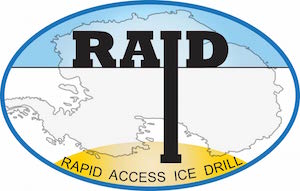The RAID drilling system was designed, fabricated and tested in Utah between 2013 and 2015, and delivered to the US Antarctic Program (USAP) in November 2015. After shipment to Antarctica the project conducted a series of Antarctic Field Trials (AFT) between 2016 and 2020 in order to test all of the components, validate performance specifications and demonstrate full capability of the drilling system in the Antarctic environment.
A timeline of key milestones includes:
- RAID design, fabrication, construction, integration, and testing were completed at the DOSECC Exploration Services facility in Salt Lake City between March 2013 and November 2015.
- Key RAID components were verified and accepted by the University of Minnesota on November 5, 2015.
- The RAID drilling system was shipped by truck to the USAP vessel facility at Port Hueneme, California in November 2015.
- RAID arrived at McMurdo Station in Antarctica on January 28, 2016.
- Antarctic field trials and technical development were completed in 2016-17 (AFT1) and 2017-18 (AFT2) at Minna Bluff in the McMurdo Station operating area. Although some operational goals were achieved, these technology development tests fell short of reaching the principal goals of rapid deep-ice penetration and coring of deep ice and subglacial bedrock.
- A technical field team was deployed to McMurdo Station in and 2018-19 in order to complete field modifications of some components, conduct further tests, and complete mechanical maintenance.
- A third set of full-scale field trials (AFT3) was conducted during the 2019–20 austral season at Minna Bluff, during which all major components were validated and the system as a whole was demonstrated to be operational.
- Following AFT3, the RAID modules were winterized and raised on snow berms. The FRS module was airlifted to the US and transported to the Matrix Drilling Products facility in Lewisburg, Tennessee in mid-2020 for further modification and upgrades.
As of 2022, the integrated RAID system is considered operational and effective drilling rapidly through thick ice and penetrating across the glacial bed to take cores of bedrock. The FRS is expected to be shipped to Antarctica in early 2024 in order to be staged for future use on the Polar Plateau.


